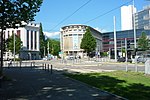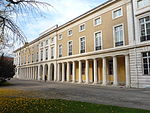Conservatoire de Grenoble
Educational institutions in Grenoble

The Conservatoire de Grenoble, in French Conservatoire à rayonnement régional de Grenoble is a Chartered artistic institution controlled by the Ministry of Culture and Communication, represented by the Regional Directorate of cultural Affairs (DRAC). The conservatory is located at 6, Chemin de Gordes 38100 Grenoble, France. The institute offers three specialties, music, dance and drama. The building is installed close to the MC2. Since 2003, the building is labeled "Heritage of the 20th century" in Grenoble.
Excerpt from the Wikipedia article Conservatoire de Grenoble (License: CC BY-SA 3.0, Authors, Images).Conservatoire de Grenoble
Chemin de Gordes, Grenoble Secteur 4
Geographical coordinates (GPS) Address External links Nearby Places Show on map
Geographical coordinates (GPS)
| Latitude | Longitude |
|---|---|
| N 45.1733 ° | E 5.7347 ° |
Address
Conservatoire national de région (Conservatoire de Grenoble)
Chemin de Gordes 6
38100 Grenoble, Secteur 4
Auvergne-Rhône-Alpes, France
Open on Google Maps








